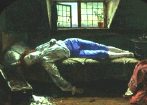Thomas Chatterton and the Rowley Poems

The Death of Chatterton, Oil Painting by Henry Wallis, 1856
Most children manage to maintain a line between their imaginary life and reality, but Chatterton's medieval fantasy world materialized into solid, tangible form when he claimed to find poetry tucked away in a back room of the church that had been written by his imaginary priest. He showed it to the law partner of his employer, a Bristol attorney, who believed it to be authentic 15th century material and bought it from him.
Emboldened by this success, Chatterton began 'finding' more of Rowley's poetry. He also produced poems using his own name, but found that anything by Chatterton was ignored, whereas work by Rowley was eagerly sought after.
In April, 1770 Chatterton left for London, determined to make it on his own merits as a writer. But a mere four months later, unable to find any work, without money, and near starvation, he penned a farewell poem and poisoned himself with arsenic. He was only seventeen years old.
Upon his death, Chatterton's work was discovered and published. It ended up becoming quite popular and exerted an enormous influence upon the later Romantic poets. Wordsworth, for instance, referred to him as 'the marvelous boy' and Keats dedicated Endymion to him.
References/Further Reading:
- Haywood, Ian. The Making of History: A Study of the Literary Forgeries of James Macpherson and Thomas Chatterton in Relation to Eighteenth-Century Ideas of History and Fiction. Rutherford, NJ: Fairleigh Dickinson University Press, 1986.
| Main Page | Comments | Search |
Back to Gallery: 1700-1799 |